A Brief History of Height
Story Highlights
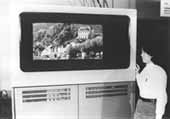
NHK's 1969 HDTV Demo
Based on the basic questions who, when, where, how, and why, HDTV was invented by NHK (Nippon Hoso Kyokai, the Japan Broadcasting Corporation), first shown to the public in 1969 at NHK’s Science & Technical Research Laboratory, initially achieved by using three image tubes to create the picture, and developed because, with real estate at a premium in Japan, viewers sat closer to TVs and, therefore, were more aware of the flaws of ordinary television. Unfortunately, that view doesn’t match the following news report:
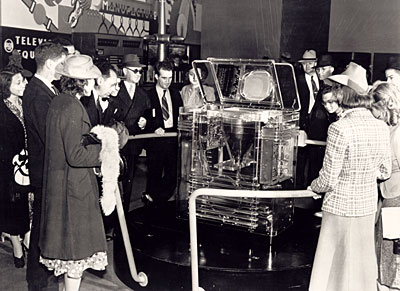 “The exposition’s opening on April 30 also marked the advent of this country’s first regular schedule of high-definition broadcasts.” That was published in the U.S. magazine Broadcasting before NHK’s unveling of HDTV, more than 30 years before, on April 30, 1939, reporting on the first day of that year’s New York World’s Fair, where RCA demonstrated what it called high-definition television.
“The exposition’s opening on April 30 also marked the advent of this country’s first regular schedule of high-definition broadcasts.” That was published in the U.S. magazine Broadcasting before NHK’s unveling of HDTV, more than 30 years before, on April 30, 1939, reporting on the first day of that year’s New York World’s Fair, where RCA demonstrated what it called high-definition television.
Broadcasting had to use the modifying phrase “this country’s” because even the 1939 demonstrations weren’t the first called HDTV. 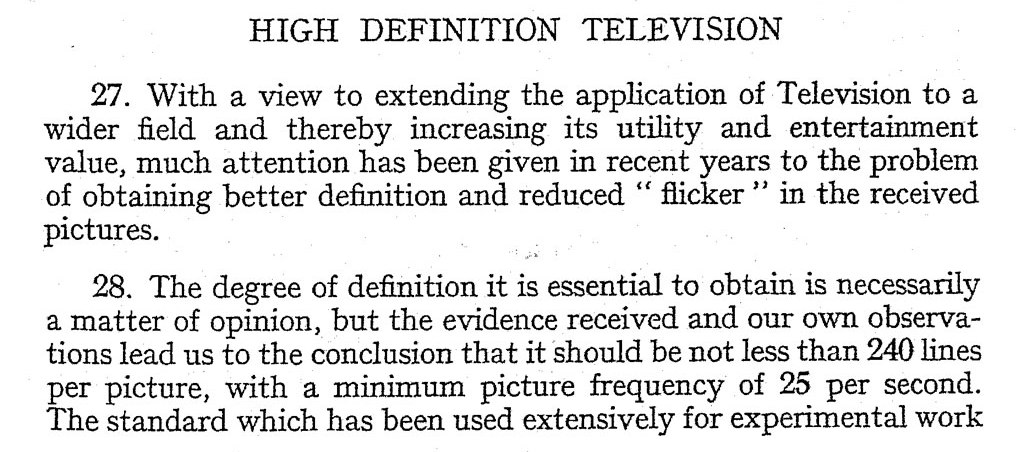 In 1935, the British Parliament’s Television Committee made its recommendations, among them the notion that any future broadcasts be HDTV. In fact, a section of the report was labeled “HIGH DEFINITION TELEVISION.” But, strangely, it defined HDTV as having no fewer than 240 lines per picture, less than half of what we called ordinary television before today’s HDTV.
In 1935, the British Parliament’s Television Committee made its recommendations, among them the notion that any future broadcasts be HDTV. In fact, a section of the report was labeled “HIGH DEFINITION TELEVISION.” But, strangely, it defined HDTV as having no fewer than 240 lines per picture, less than half of what we called ordinary television before today’s HDTV.
How can 240 lines be considered HDTV? Consider one more basic question: what? What is HDTV? Ease into it by considering a different question: What is a computer?  You might come up with a definition involving circuitry or programming, hardware or software. But did you think of it as a career? Today we might refer to someone who can perform elaborate calculations as a “human computer,” but, back when the word computer referred to people who calculated for a living, it was the non-human varieties that needed modifying adjectives: mechanical computer, electronic computer, etc. ENIAC was an electronic numerical integrator and computer.
You might come up with a definition involving circuitry or programming, hardware or software. But did you think of it as a career? Today we might refer to someone who can perform elaborate calculations as a “human computer,” but, back when the word computer referred to people who calculated for a living, it was the non-human varieties that needed modifying adjectives: mechanical computer, electronic computer, etc. ENIAC was an electronic numerical integrator and computer.
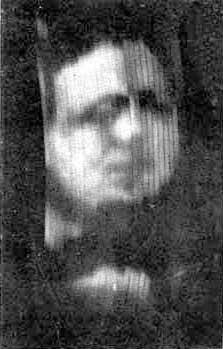
30-line TV
John Logie Baird achieved the first recognizable video image of a human face in 1925. He began with just eight scanning lines, but by the time he started broadcasting he was up to 30. For many years, 30-line television was considered the norm. Herbert E. Ives, who directed AT&T’s television research, explained the choice of a somewhat higher figure in 1927 because, “it is known that the human face can be satisfactorily reproduced by a 50-line screen.” But, if the normal television pictures of the 1920s had 30- or 50-line pictures, what should the 180-line and higher-definition television pictures of the 1930s be called? HDTV, of course.
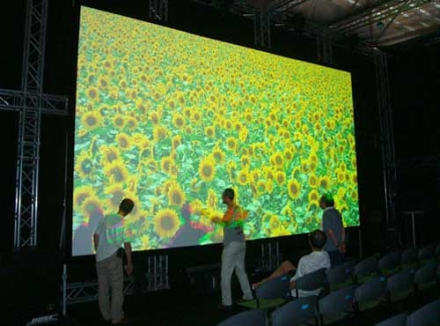 As ordinary consumers adopted television after World War II, it quickly became just TV. Thousand-line images had been proposed even before the war, but standards froze the number of lines per picture until what we now call HDTV. Of course, it, too, might be a temporary label. NHK has long been demonstrating something currently called ultra-HDTV, with 16 times more picture elements than the highest-definition form of HDTV today.
As ordinary consumers adopted television after World War II, it quickly became just TV. Thousand-line images had been proposed even before the war, but standards froze the number of lines per picture until what we now call HDTV. Of course, it, too, might be a temporary label. NHK has long been demonstrating something currently called ultra-HDTV, with 16 times more picture elements than the highest-definition form of HDTV today.
Is it possible for humans to perceive that much picture definition? That’s something I hope to address later. But it’s easy to imagine that, after today’s HDTV becomes just TV, UHDTV will become just HDTV.
And when UHDTV becomes just TV? The mind boggles.
